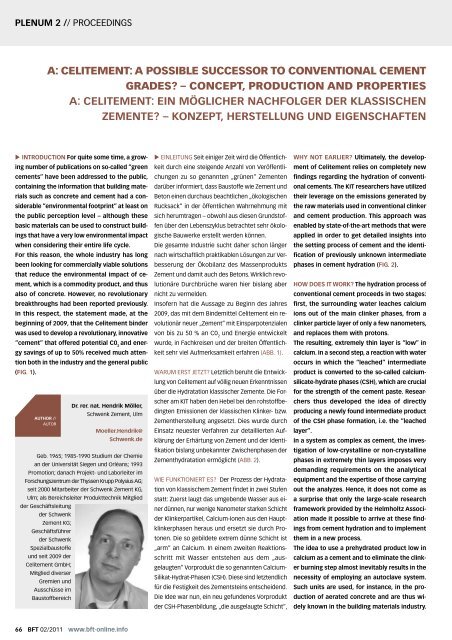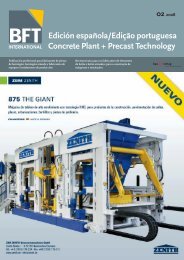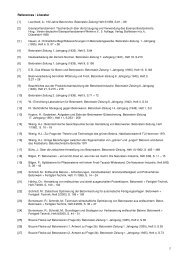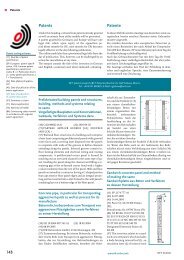Tagungsband - BFT International
Tagungsband - BFT International
Tagungsband - BFT International
Erfolgreiche ePaper selbst erstellen
Machen Sie aus Ihren PDF Publikationen ein blätterbares Flipbook mit unserer einzigartigen Google optimierten e-Paper Software.
PLENUM 2 // PROCEEDINGS<br />
� INTRODUCTION For quite some time, a grow-<br />
ing number of publications on so-called “green<br />
cements” have been addressed to the public,<br />
containing the information that building mate-<br />
rials such as concrete and cement had a con-<br />
siderable “environmental footprint” at least on<br />
the public perception level – although these<br />
basic materials can be used to construct build-<br />
ings that have a very low environmental impact<br />
when considering their entire life cycle.<br />
For this reason, the whole industry has long<br />
been looking for commercially viable solutions<br />
that reduce the environmental impact of ce-<br />
ment, which is a commodity product, and thus<br />
also of concrete. However, no revolutionary<br />
breakthroughs had been reported previously.<br />
In this respect, the statement made, at the<br />
beginning of 2009, that the Celitement binder<br />
was used to develop a revolutionary, innovative<br />
“cement” that offered potential C0 2 and ener-<br />
gy savings of up to 50% received much atten-<br />
tion both in the industry and the general public<br />
(FIG. 1).<br />
AUTHOR //<br />
AUTOR<br />
A: CELITEMENT: A POSSIBLE SUCCESSOR TO CONVENTIONAL CEMENT<br />
GRADES? – CONCEPT, PRODUCTION AND PROPERTIES<br />
A: CELITEMENT: EIN MÖGLICHER NACHFOLGER DER KLASSISCHEN<br />
ZEMENTE? – KONZEPT, HERSTELLUNG UND EIGENSCHAFTEN<br />
Dr. rer. nat. Hendrik Möller,<br />
Schwenk Zement, Ulm<br />
Moeller.Hendrik@<br />
Schwenk.de<br />
Geb. 1965; 1985-1990 Studium der Chemie<br />
an der Universität Siegen und Orléans; 1993<br />
Promotion; danach Projekt- und Laborleiter im<br />
Forschungszentrum der Thyssen Krupp Polysius AG;<br />
seit 2000 Mitarbeiter der Schwenk Zement KG,<br />
Ulm; als Bereichsleiter Produkttechnik Mitglied<br />
der Geschäftsleitung<br />
der Schwenk<br />
Zement KG;<br />
Geschäftsführer<br />
der Schwenk<br />
Spezialbaustoffe<br />
und seit 2009 der<br />
Celitement GmbH;<br />
Mitglied diverser<br />
Gremien und<br />
Ausschüsse im<br />
Baustoffbereich<br />
66 <strong>BFT</strong> 02/2011 www.bft-online.info<br />
� EINLEITUNG Seit einiger Zeit wird die Öffentlich-<br />
keit durch eine steigende Anzahl von Veröffentli-<br />
chungen zu so genannten „grünen“ Zementen<br />
darüber informiert, dass Baustoffe wie Zement und<br />
Beton einen durchaus beachtlichen „ökologischen<br />
Rucksack“ in der öffentlichen Wahrnehmung mit<br />
sich herumtragen – obwohl aus diesen Grundstof-<br />
fen über den Lebenszyklus betrachtet sehr ökolo-<br />
gische Bauwerke erstellt werden können.<br />
Die gesamte Industrie sucht daher schon länger<br />
nach wirtschaftlich praktikablen Lösungen zur Ver-<br />
besserung der Ökobilanz des Massenprodukts<br />
Zement und damit auch des Betons. Wirklich revo-<br />
lutionäre Durchbrüche waren hier bislang aber<br />
nicht zu vermelden.<br />
Insofern hat die Aussage zu Beginn des Jahres<br />
2009, das mit dem Bindemittel Celitement ein re-<br />
volutionär neuer „Zement“ mit Einsparpotenzialen<br />
von bis zu 50 % an C0 2 und Energie entwickelt<br />
wurde, in Fachkreisen und der breiten Öffentlich-<br />
keit sehr viel Aufmerksamkeit erfahren (ABB. 1).<br />
WARUM ERST JETZT? Letztlich beruht die Entwick-<br />
lung von Celitement auf völlig neuen Erkenntnissen<br />
über die Hydratation klassischer Zemente. Die For-<br />
scher am KIT haben den Hebel bei den rohstoffbe-<br />
dingten Emissionen der klassischen Klinker- bzw.<br />
Zementherstellung angesetzt. Dies wurde durch<br />
Einsatz neuester Verfahren zur detaillierten Auf-<br />
klärung der Erhärtung von Zement und der Identi-<br />
fikation bislang unbekannter Zwischenphasen der<br />
Zementhydratation ermöglicht (ABB. 2).<br />
WIE FUNKTIONIERT ES? Der Prozess der Hydrata-<br />
tion von klassischem Zement findet in zwei Stufen<br />
statt: Zuerst laugt das umgebende Wasser aus ei-<br />
ner dünnen, nur wenige Nanometer starken Schicht<br />
der Klinkerpartikel, Calcium-Ionen aus den Haupt-<br />
klinkerphasen heraus und ersetzt sie durch Pro-<br />
tonen. Die so gebildete extrem dünne Schicht ist<br />
„arm“ an Calcium. In einem zweiten Reaktions-<br />
schritt mit Wasser entstehen aus dem „aus-<br />
gelaugten“ Vorprodukt die so genannten Calcium-<br />
Silikat-Hydrat-Phasen (CSH). Diese sind letztendlich<br />
für die Festigkeit des Zementsteins entscheidend.<br />
Die Idee war nun, ein neu gefundenes Vorprodukt<br />
der CSH-Phasenbildung, „die ausgelaugte Schicht“,<br />
WHY NOT EARLIER? Ultimately, the develop-<br />
ment of Celitement relies on completely new<br />
findings regarding the hydration of conventi-<br />
onal cements. The KIT researchers have utilized<br />
their leverage on the emissions generated by<br />
the raw materials used in conventional clinker<br />
and cement production. This approach was<br />
enabled by state-of-the-art methods that were<br />
applied in order to get detailed insights into<br />
the setting process of cement and the identi-<br />
fication of previously unknown intermediate<br />
phases in cement hydration (FIG. 2).<br />
HOW DOES IT WORK? The hydration process of<br />
conventional cement proceeds in two stages:<br />
first, the surrounding water leaches calcium<br />
ions out of the main clinker phases, from a<br />
clinker particle layer of only a few nanometers,<br />
and replaces them with protons.<br />
The resulting, extremely thin layer is “low” in<br />
calcium. In a second step, a reaction with water<br />
occurs in which the “leached” intermediate<br />
product is converted to the so-called calcium-<br />
silicate-hydrate phases (CSH), which are crucial<br />
for the strength of the cement paste. Resear-<br />
chers thus developed the idea of directly<br />
producing a newly found intermediate product<br />
of the CSH phase formation, i.e. the “leached<br />
layer”.<br />
In a system as complex as cement, the inves-<br />
tigation of low-crystalline or non-crystalline<br />
phases in extremely thin layers imposes very<br />
demanding requirements on the analytical<br />
equipment and the expertise of those carrying<br />
out the analyzes. Hence, it does not come as<br />
a surprise that only the large-scale research<br />
framework provided by the Helmholtz Associ-<br />
ation made it possible to arrive at these find-<br />
ings from cement hydration and to implement<br />
them in a new process.<br />
The idea to use a prehydrated product low in<br />
calcium as a cement and to eliminate the clink-<br />
er burning step almost inevitably results in the<br />
necessity of employing an autoclave system.<br />
Such units are used, for instance, in the pro-<br />
duction of aerated concrete and are thus wi-<br />
dely known in the building materials industry.












